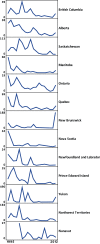Pertussis Surveillance in Canada: Trends to 2012
- PMID: 29769879
- PMCID: PMC5864426
- DOI: 10.14745/ccdr.v40i03a01
Pertussis Surveillance in Canada: Trends to 2012
Abstract
Objective: The purpose of this report is to provide a summary of the pertussis activity in Canada.
Methods: A descriptive analysis of pertussis incidence by year, age group, gender and province/territory was conducted using national surveillance data, clinical administrative data and vital statistics data.
Results: Pertussis is an endemic cyclical disease in Canada with peaks in activity occurring every 2 to 5 years. Canada has experienced a decline in pertussis activity following the introduction of routine pertussis immunization programs. The incidence of pertussis is highest in infants and children. Hospitalization and mortality are more common among infants, particularly those less than three months of age. Trends in pertussis vary by province and territory. Canada experienced a notable increase in incidence in 2012. Reasons for this increase are unknown.
Conclusion: Our understanding of the epidemiology of pertussis in Canada could be enhanced by improved approaches for monitoring the disease. Although the peak in activity observed in 2012 could be an isolated event, further work to support outbreak response in provinces and territories, including rapid research tools and resources, should be considered.
Figures






References
-
- Public Health Agency of Canada. Publicly funded Immunization Programs in Canada - Routine Schedule for Infants and Children including special programs and catch-up programs (as of March 2013). http://www.phac-aspc.gc.ca/im/ptimprog-progimpt/table-1-eng.php
-
- Public Health Agency of Canada. National Notifiable Diseases. http://www.phac-aspc.gc.ca/aids-sida/about/dis-eng.php
-
- Health and Welfare Canada. Canadian Communicable Disease Surveillance System. Disease-specific case definitions and surveillance methods. Can Dis Wkly Rep 1991;17 Suppl 3:1–35. - PubMed
-
- Health Canada. Case definitions for diseases under national surveillance. Can Commun Dis Rep 2000. May;26 Suppl 3:i–iv. - PubMed
-
- Public Health Agency of Canada. Case definitions for communicable diseases under national surveillance. Can Commun Dis Rep 2009;35 Suppl 2.

